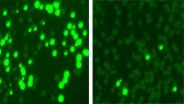(Press-News.org) The multitude of microbes scientists have found populating the human body have good, bad and mostly mysterious implications for our health. But when something goes wrong, we defend ourselves with the undiscriminating brute force of traditional antibiotics, which wipe out everything at once, regardless of the consequences.
Researchers at Rockefeller University and their collaborators are working on a smarter antibiotic. And in research to be published October 5 in Nature Biotechnology, the team describes a 'programmable' antibiotic technique that selectively targets the bad bugs, particularly those harboring antibiotic resistance genes, while leaving other, more innocent microbes alone.
"In experiments, we succeeded in instructing a bacterial enzyme, known as Cas9, to target a particular DNA sequence and cut it up," says lead researcher Luciano Marraffini, head of the Laboratory of Bacteriology. "This selective approach leaves the healthy microbial community intact, and our experiments suggest that by doing so you can keep resistance in check and so prevent certain types of secondary infections, eliminating two serious hazards associated with treatment by classical antibiotics."
The new approach could, for instance, reduce the risk of C. diff, a severe infection of the colon, caused by the Clostridium difficile bacterium, that is associated with prolonged courses of harsh antibiotics and is a growing public health concern.
The Cas9 enzyme is part of a defense system that bacteria use to protect themselves against viruses. The team coopted this bacterial version of an immune system, known as a CRISPR (clustered regularly interspaced short palindromic repeats) system and turned it against some of the microbes. CRISPR systems contain unique genetic sequences called spacers that correspond to sequences in viruses. CRISPR-associated enzymes, including Cas9, use these spacer sequences as guides to identify and destroy viral invaders.
The researchers were able to direct Cas9 at targets of their choosing by engineering spacer sequences to match bacterial genes then inserting these sequences into a cell along with the Cas9 gene. The cell's own machinery then turns on the system. Depending on the location of the target in a bacterial cell, Cas9 may kill the cell or it may eradicate the target gene. In some cases, a treatment may prevent a cell from acquiring resistance, they found.
"We previously showed that if Cas9 is programmed with a target from a bacterial genome, it will kill the bacteria. Building on that work, we selected guide sequences that enabled us to selectively kill a particular strain of microbe from within a mixed population," says first author David Bikard, a former Rockefeller postdoc who is now at the Pasteur Institute in Paris.
In initial experiments, Bikard and colleagues targeted a strain of the common skin and respiratory bacteria Staphylococcus aureus that is resistant to the antibiotic kanamycin. Treatment by Cas9 programmed to target a part of the resistance gene killed most of the resistant Staph, but left behind the kanamycin-susceptible Staph.
Targeted bacterial genocide is only one option. Bacteria share genes, including those conferring drug resistance, in the form of rings of DNA known as plasmids. In a second series of experiments, researchers turned Cas9 on tetracycline resistance-harboring plasmids in a strain of the potentially deadly multidrug resistant bacteria Staphylococcus aureus (MRSA). Not only did the resistant cells become sensitive to tetracycline after Cas9 destroyed the plasmids, but the arrival of Cas9 in other Staph cells acted as an immunization, preventing them from taking on resistance-carrying plasmids.
And, in a final set of experiments, conducted in collaboration with Vincent Fischetti's Laboratory of Bacterial Pathogenesis and Immunology, adjunct faculty member Chad Euler confirmed their test tube results on living skin, by using Cas9 to selectively kill kanamycin-resistant Staph infecting the shaved backs of mice.
In spite of the promising results, the delivery system needs improvement. The researchers used bacteria-infecting viruses to inject the programmed Cas9 enzymes into the bacterial cells, but these viruses only attack specific types of cells. Scientists need to devise a less discriminating method of delivery, before the technology can be used to develop a new class of antibiotics, Marraffini says.
In addition to its potential as a much-needed new weapon against drug-resistant microbes, the new system could also be used to advance research on the complex populations of microbes in the body, about which very little is known. "There are enormous microbial communities in the human body," Marraffini says. "Programmable Cas9 enzymes may make it possible to analyze these populations by eliminating their members, one by one, and studying the effects."
INFORMATION:
Type 2 diabetes affects an estimated 28 million Americans according to the American Diabetes Association, but medications now available only treat symptoms, not the root cause of the disease. New research from Rutgers shows promising evidence that a modified form of a different drug, niclosamide – now used to eliminate intestinal parasites – may hold the key to battling the disease at its source.
The study, led by Victor Shengkan Jin, an associate professor of pharmacology at Rutgers Robert Wood Johnson Medical School, has been published online by the journal Nature ...
Montréal, October 2, 2014 – Scientists at the IRCM discovered a mechanism that promotes the progression of medulloblastoma, the most common brain tumour found in children. The team, led by Frédéric Charron, PhD, found that a protein known as Sonic Hedgehog induces DNA damage, which causes the cancer to develop. This important breakthrough will be published in the October 13 issue of the prestigious scientific journal Developmental Cell. The editors also selected the article to be featured on the journal's cover.
Sonic Hedgehog belongs to a family of proteins that gives ...
Despite the legalization of same-sex marriage in 19 states and the District of Columbia and an executive order to prohibit federal contractors from discrimination against lesbian, gay, bisexual, and transgender employees, LGBT individuals face tremendous hurdles in access to health care and basic human rights. A special report published by The Hastings Center, LGBT Bioethics: Visibility, Disparities, and Dialogue, is a call to action for the bioethics field to help right the wrongs in the ways that law, medicine, and society have treated LGBT people.
The editors are Tia ...
FALLS CHURCH, Va. (October 3, 2014) — A new National Institute for Occupational Safety and Health (NIOSH) study, published online in the Journal of Occupational and Environmental Hygiene, found that recommended safe handling practices for workers who administer antineoplastic drugs in healthcare settings are not always followed.
Results are derived from the 2011 Health and Safety Practices Survey of Healthcare Workers, the largest federally-sponsored survey of healthcare workers in the U.S., which addresses safety and health practices relative to use of hazardous chemicals. ...
Men who consume more alcohol have a greater risk of human papillomavirus (HPV) infection, according to a recent study by Moffitt Cancer Center researchers.
HPV is a common sexually transmitted virus, with more than six million new infections in the United States each year. HPV causes genital warts in both men and women and is a contributing factor to a number of different cancers in women, including cervical, vaginal and anal cancers. More recent studies have shown that HPV can also cause penile, anal and oropharyngeal cancer in men. However, there is limited data regarding ...
A snaking, extended filament of solar material currently lies on the front of the sun-- some 1 million miles across from end to end. Filaments are clouds of solar material suspended above the sun by powerful magnetic forces. Though notoriously unstable, filaments can last for days or even weeks.
NASA's Solar Dynamics Observatory, or SDO, which watches the sun 24 hours a day, has observed this gigantic filament for several days as it rotated around with the sun. If straightened out, the filament would reach almost across the whole sun, about 1 million miles or 100 times ...
In response to the rise of drug-resistant pathogens, doctors are routinely cautioned against overprescribing antimicrobials. But when a patient has a confirmed bacterial infection, the advice is to treat aggressively to quash the infection before the bacteria can develop resistance.
A new study questions the accepted wisdom that aggressive treatment with high drug dosages and long durations is always the best way to stem the emergence and spread of resistant pathogens. The review of nearly 70 studies of antimicrobial resistance, which was authored by researchers at Princeton ...
Two NASA satellites captured data on Typhoon Phanfone as it continues to strengthen as it moves through the Northwestern Pacific Ocean.
The Tropical Rainfall Measuring Mission or TRMM satellite flew over Typhoon Phanfone on Oct. 2, 2014 at 0939 UTC (5:39 a.m. EDT). The rainfall pattern observed using TRMM's Microwave Imager (TMI) and Precipitation Radar (PR) data showed that Phanfone was much better organized than a day earlier. This precipitation analysis revealed that intensifying typhoon Phanfone had formed a large eye. The heaviest rainfall was shown falling at a ...
NASA's Terra satellite spotted the birth of Tropical Storm Vongfong in the Northwestern Pacific Ocean on Oct. 3. Vongfong is the nineteenth tropical storm of the Northwestern Pacific typhoon season.
The MODIS or Moderate Resolution Imaging Spectroradiometer instrument that flies aboard NASA's Terra satellite captured a visible image of Tropical Storm Vongfong on Oct. 3 at 00:30 UTC (Oct. 2 at 8:30 p.m. EDT). At the time of the image, the center of Tropical Storm Vongfong was located just to the northeast of Pohnpei, one of four states in the Federated States of Micronesia. ...
Tropical Storm Simon is following the path of several other tropical storms that formed in the Eastern Pacific Ocean by crawling northward along the western coastline of Mexico. NOAA's GOES-West satellite captured an infrared image of Simon on Oct. 3 that showed the eastern side of the storm over Mexico.
An infrared image taken from NOAA's GOES-West satellite on Oct .3 at 7:45 a.m. EDT showed strong thunderstorms circling Tropical Storm Simon's center and a fragmented band of thunderstorms in Simon's eastern quadrant bringing rainfall to western Mexico. Simon's center ...





